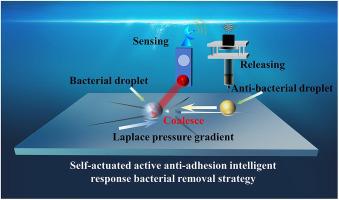Chemical Engineering Journal ( IF 13.3 ) Pub Date : 2023-10-01 , DOI: 10.1016/j.cej.2023.146348 Hanqing Lu , Jing Lin , Jin Lin , Zihan Hua , Fei Hu , Liangjuan Ouyang

|
The adhesion of adverse bacteria to material surfaces increases the risk of microbial corrosion and bacterial transmission. Superhydrophobic and superhydrophilic-type bacterial anti-adhesion approaches have been explored; however, these approaches are static and passive. This study proposes an active-bacterial anti-adhesion strategy based on the directional transportation of bacterial droplets on a star-shaped intelligent response platform (SIRP) for droplet self-actuation. Bacteria and other droplets can self-actuate on the SIRP, where droplets are in a superhydrophobic Cassie–Baxter wetting state, owing to the generated Laplace pressure gradient force on the wedge-shaped groove and extremely small adhesion resistance. The velocity and distance travelled of self-actuated droplets depend on various factors such as the opening angle, etching depth of the wedge-shaped groove, modified perfluorodecyltrimethoxysilane density, and droplet volume. Experimental and finite element simulation results confirm the continuous increase and sharp decrease in Laplace pressure difference in the self-actuated and non-self-actuated zones, respectively. The SIRP demonstrates superior bacterial anti-adhesion during bacterial droplet self-actuation and a very smart infrared-sensing sterilization or micro-reaction response to different types of droplets. The SIRP not only opens a new avenue for active bacterial anti-adhesion strategies but also offers a promising application for smart controllable micro-reactions.
中文翻译:

自驱动红外传感响应平台上基于拉普拉斯压力梯度自驱动液滴定向输送的活性细菌防粘附策略
有害细菌粘附在材料表面会增加微生物腐蚀和细菌传播的风险。探索了超疏水和超亲水型细菌抗粘附方法;然而,这些方法是静态和被动的。本研究提出了一种基于星形智能响应平台(SIRP)上细菌液滴定向运输的主动细菌抗粘附策略,用于液滴自驱动。细菌和其他液滴可以在SIRP上自我驱动,由于楔形凹槽上产生的拉普拉斯压力梯度力和极小的粘附阻力,液滴处于超疏水的Cassie-Baxter润湿状态。自驱动液滴的速度和行进距离取决于多种因素,例如张开角度、楔形凹槽的蚀刻深度、改性全氟癸基三甲氧基硅烷密度和液滴体积。实验和有限元模拟结果证实了自驱动区和非自驱动区拉普拉斯压差分别持续增大和急剧减小。SIRP 在细菌液滴自驱动过程中表现出卓越的细菌抗粘附性,并且对不同类型的液滴具有非常智能的红外感应灭菌或微反应响应。SIRP不仅为活性细菌抗粘附策略开辟了一条新途径,而且还为智能可控微反应提供了有前景的应用。实验和有限元模拟结果证实了自驱动区和非自驱动区拉普拉斯压差分别持续增大和急剧减小。SIRP 在细菌液滴自驱动过程中表现出卓越的细菌抗粘附性,并且对不同类型的液滴具有非常智能的红外感应灭菌或微反应响应。SIRP不仅为活性细菌抗粘附策略开辟了一条新途径,而且还为智能可控微反应提供了有前景的应用。实验和有限元模拟结果证实了自驱动区和非自驱动区拉普拉斯压差分别持续增大和急剧减小。SIRP 在细菌液滴自驱动过程中表现出卓越的细菌抗粘附性,并且对不同类型的液滴具有非常智能的红外感应灭菌或微反应响应。SIRP不仅为活性细菌抗粘附策略开辟了一条新途径,而且还为智能可控微反应提供了有前景的应用。SIRP 在细菌液滴自驱动过程中表现出卓越的细菌抗粘附性,并且对不同类型的液滴具有非常智能的红外感应灭菌或微反应响应。SIRP不仅为活性细菌抗粘附策略开辟了一条新途径,而且还为智能可控微反应提供了有前景的应用。SIRP 在细菌液滴自驱动过程中表现出卓越的细菌抗粘附性,并且对不同类型的液滴具有非常智能的红外感应灭菌或微反应响应。SIRP不仅为活性细菌抗粘附策略开辟了一条新途径,而且还为智能可控微反应提供了有前景的应用。











































 京公网安备 11010802027423号
京公网安备 11010802027423号